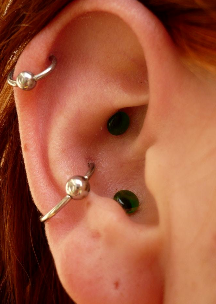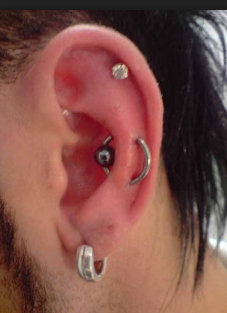Lobe piercing
This is the most popular area of the ear to get a piercing.
A single hole in the middle of the lobe has been as popular as perhaps ear piercing itself, though we get to see more than one piece of jewellery in the ear lobe itself these days.
At present, ear lobe piercing can be done with the help of a gun or a needle. Though a gun piercing hurts lesser, piercing with a sterilized needle is a better alternative.
The lobe piercing heals very fast (within 4-6 weeks ) and is not very likely to get infections.
Cartilage, also called helix piercings, are very popular. They seem easy to mantain, however there are a few downsides of having them.
Helix piercing refers to a piercing that involves the soft cartilage at the upper side of the ear. Most professionals prefer to do the helix piercing with the gun though a large needle can also be used for the purpose.
They are not hard to care for- you basically just have to take care of them the same way as you do your lobes: clean them with the cleanser they give you 3 times daily. Also, to speed up the healing process, you can soak your piercing in a warm cup of sea salt water for a few minutes.
Cons
The risk of infection (God forbid!) for a cartilage piercing is higher than the risk of infection with your lobe piercings. A helix piercing takes a very long time to heal. While some people claim to be fully healed within 6-8 months, it is usually known to take as long as 12 months to heal in most people.
When you have a new cartilage piercing, make sure to keep your hair up and away from your piercing, you have to make sure to keep your sheets, pillow cases and hair clean. This will minimize the risk of infection in your piercing.
If you are going to get both ears pierced, get one at a time. This is because you will not be able to sleep on the side you get pierced comfortably for a few weeks.
If you get an infection, soak your piercing in a sea salt soak 2-3 times a day, and it should clear up. If it doesn't clear up and starts to get worse, go to a doctor so they can give you some antibiotics to cure the infection.
If you decide to take it out and let it close, it may result in a keloid on your ear. You may notice that you have a soft bump on the back or front of your ear around your piercing. Just keep cleaning your piercing as normal, and eventually it will go away.
Rook piercing
Due to rook piercing pain and the amount of time it takes the wound to heal, this procedure isn’t for everyone.
Those who wonder does rook piercing hurt will not be happy to know that: It is extremely painful for the wearer since the needle in this case passes through several layers of cartilage. Besides, it is very difficult to perform as well because the entrance and exit holes are not always easy to mark. the procedure itself is not overly troublesome, it is the weeks and months after that are the worst.
The healing time with these perforations is long and can last as long as 12 months. Lobes, for example, tend to heal up nicely in about a month; cartilage does not have that ability. This means that there are plenty of chances for infection to set in, not to mention irritation that can be quite painful.
Constant care must be paid to these types of piercings, and neglecting them for only a matter of days can have disastrous consequences. As such, people who don’t think they have it in them to carefully clean and disinfect a fresh wound at least twice a day, every single day, for up to a year should seriously reconsider this type of adornment. Furthermore, they must keep in mind that an infection of this area is no laughing matter. Left untreated, an infection can spread throughout the rest of the body.
Not everyone who gets one of these earrings will suffer from infection, likely suffer through some of the other symptoms that go along with the mending process. These include redness, throbbing and burning sensations, itching and swelling.
In the event your ear does become infected, you cannot simply remove the stud in the hopes of clearing the ailment up. This is actually the worst thing you can do because once the hole closes up, you will have closed up the only channel the infection had to drain. The consequences of that could include being put on an antibiotic regime or possibly surgery.
Daith Piercing consists of perforating the specified part of inner cartilage using a curved surgical needle.
The process can be quite hurtful. If you can bear much pain, you can safely go for this process. After piercing, the area is cleaned to remove all traces of blood. In experienced hands, Daith Piercing bleeding is minimal.
Daith Piercing has become popular only recently.
If you are interested in getting a Daith Piercing, you should find out if any local salon in your area is offering such services. Painkillers like Acetaminophen, Aspirin or Ibuprofen, will help if you have a low threshold for pain. You may pop these sometime before the session begins to reduce pain during piercing.
The professional will probably mark the spot with a surgical pen and then start cleaning the area. The area is cleaned with a disinfectant containing alcohol and antiseptic lotions.
Daith piercing is done at the innermost fold of the ear cartilage using a curved needle. Using a curved needle prevents any damage to the other parts of the ear.
Some people have hair coming out of their ear. In such cases, the piercer may shave the area to carry out a minor hair removal.
These piercings take unduly long to heal and while they might stop hurting after 4-6 weeks, they are known to take as long as 2-4 months to heal completely.
Aftercare
Most piercers recommend a salt water soak for the pierced area.
You can go for H2Ocean solutions from the market or make a solution yourself. Add 1 tsp salt into 1 glass (8 ounces) of water and mix well.
Dip a cotton ball into the solution and press to your pierced area to clean it off impurities. Repeat the process with fresh cotton balls for 5 minutes.
You should preferably do this twice a day. Wash your hand with antibacterial soap before and after the cleaning session. This will avoid any transmission of germs from your hand to the area. After Daith Piercing earphones are best avoided. Inserting headphones into the ear canal can cause swelling and delay the recovery process.
Conch piercings are among the most risky of ear cartilage piercings. The conch is a popular location for large plugs, damage to the cartilage and subsequent infection are the most common risks. Conch piercings can be of two types- inner conch piercings, and outer conch piercings.
Il piercing conchiglia interna è verso il centro dell'orecchio e viene effettuata con l'aiuto di un ago di grande calibro penetrante. Barrette o cerchi di piccole dimensioni sono indossati con piercing conchiglia interna.
The outer conch piercing is along the outer part of the ear cartilage. If it is done at the curved part of the cartilage inside the ear, it will be called a helix piercing rather than an outer conch.
Large conch piercings should be done with a dermal punch, since it's less damaging to the tissue. You can't stretch cartilage, so if you want to wear plugs,the hole has to be carved/cut out.
Because of the secure location near the center of the outer ear, conch piercings pose little to no chance of rejection or migration. If you decide to go with a larger conch piercing, which will require a dermal punch, you should be aware that it will produce a lot of blood. Usually, conch piercings take 6- months to heal completely, though they stop hurting after 10 weeks or so. Cartilage piercings are slow healers and almost always encounter some problems along the way.
Snug piercing
A snug piercing perforation is done along the anti-helix. Snug refers to the area of the ear along the inner cartilage, near the base of the outer rim of the ear.
The cartilage along this part of the ear is thin due to which This is why snug piercing is a very painful experience, and a skilled artist is needed to create a piercing that doesn't put undue stress on each side of the ridge. Incorrect balance can cause irreversible damage to the cartilage.
There are many problems that may arise from snug piercing especially if the piercing was done by somebody with no proper experience in piercings. Unsterilized needles that were used for piercing the snug portion of the ear may cause infections.
When complications occur during the piercing of the snug, the affected area may get inflamed. When this happens, a person may develop fever and may become weak.
Adorned after perforation with curved barbells or hoops, this type of ear piercing can take 2-4 months for initial healing though complete healing might take upto 1 year.
Tragus piercings
This type of piercing, as indicated by the name, is done on the part of the ear called the tragus (meaning thereby that small oval cartilage flap that is situated just above the ear lobe).
Getting the ear pierced in this area can be extremely painful since the tragus is often thick and fleshy, though the thickness of this small piece of flesh varies from person to person. Some tragi are smaller than others and may be more difficult - or even not possible - to pierce.
A tragus piercing takes anywhere from 3-6 months for initial healing, though complete healing might take almost 1 year.
Any ear cartilage piercing is tricky to heal, but the tragus especially gets in the way when talking on the phone, listening to earphones/earbuds.
This piercing requires two holes in the upper cartilaginous portion of the ear. made using sterile hollow piercing needle, on opposite sides of the same ear. One is usually close to the top of the head in front of the tip of the ear (known as an anti-helix piercing) and the other is made diagonally from the first (helix piercing).
A straight barbell is then inserted through the first piercing from behind the ear, runs over the cartilage of the inner ear and comes out through the back of the second piercing. The bar is secured without a pair of captive bead rings (CBR’s) or with barbells on each end. Alternately, flexible plastic tubes can be used and the metal bar inserted after healing
This is just a variation of the helix piercing, the only difference being that the ear in this case is pierced at two places instead of one.
Two or more industrials on one ear is sometimes referred to as an ear cage.
A scaffold piercing or an industrial also takes a very long time to heal. It often takes a year to heal completely though the initial pain starts lessening after 3 months.
Gauging or stretching
Gauging/ stretching refers to a piercing along the ear lobe which is then stretched eventually over a prolonged period of time to almost form a hole along the earlobe. You start out with a normal piercing then gradually, using special tapers or plugs, make the hole bigger. It can be stretched to make it as large as desired, because the skin in the earlobe is highly elastic
It’s basically having a larger-than-average hole in your ear lobe so you can wear various jewels, plugs or so-called flesh tunnels.
Most piercers refuse to punch large holes, because totally removing a huge plug of tissue makes it difficult, if not impossible, to size back down later.
How to treat a piercing infection.
Proper care of your piercing should help you prevent infection from the beginning. Wash your hands before you touch freshly pierced areas. Use a salt water wash from day one. Turn your piercing as recommended while cleaning but do not yank on it. If you are having a metal reaction have your piercing changed to a different kind of metal, preferably nickel free. Surgical stainless steel or titanium are best
Most piercings will be swollen and sore for a few days to two weeks after the piercing is done. Having a light or clear discharge from the piercing is also normal during the first two days.
 There are many signs to look for to determine if your piercing is infected. A dark discharge or a piercing that is painfully swollen or warm to the touch are common indicators. In addition if you are running a fever, the pierced area has an unusual odor or there is black tissue building around the opening the piercing is infected.
There are many signs to look for to determine if your piercing is infected. A dark discharge or a piercing that is painfully swollen or warm to the touch are common indicators. In addition if you are running a fever, the pierced area has an unusual odor or there is black tissue building around the opening the piercing is infected.Most minor infections from body piercings can be treated by rinsing or soaking in warm salt water. Use non-iodized salt or sea salt. Diluted white vinegar can also be used as a wash or compress. Use about one part white vinegar to six parts water. After using vinegar wash the area with an antimicrobial soap and rinse well.
Rubbing alcohol can be used occasionally with moderation. Do not use hydrogen peroxide.
If the infection does not clear up, you need to seek professional treatment. When you consult a doctor there are two things to keep in mind. First, try not to remove your piercing. When the piercing is removed the outside openings will heal first trapping infection inside. Second, avoid antibiotics if at all possible. Using antibiotics can cause the piercing to reject or push its way out.


























